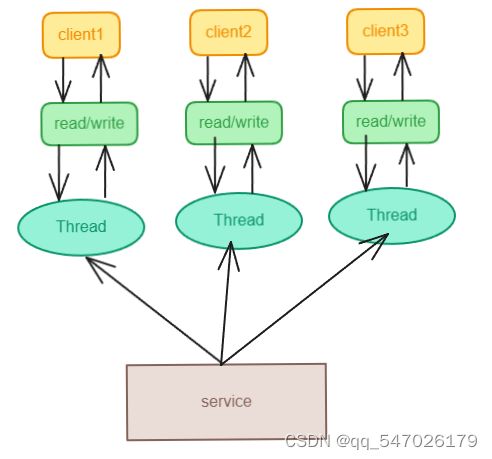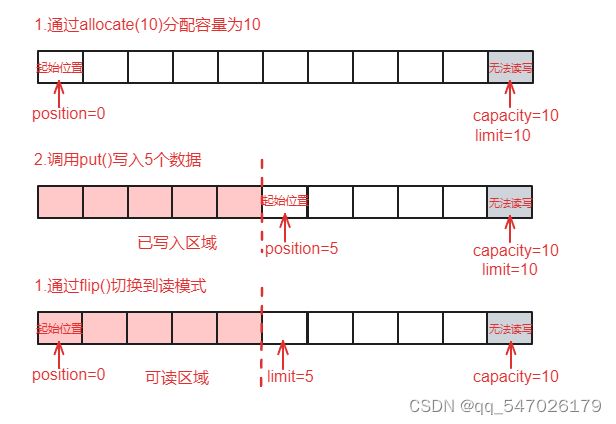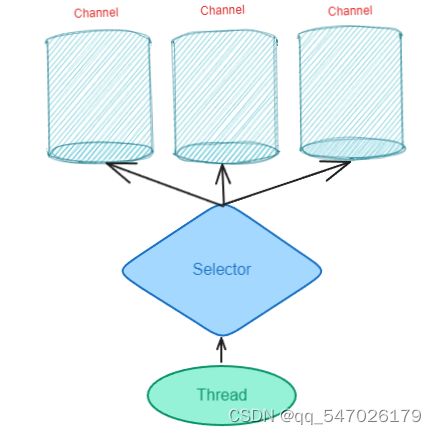Java NIO 详解
一、NIO简介
NIO 是 Java SE 1.4 引入的一组新的 I/O 相关的 API,它提供了非阻塞式 I/O、选择器、通道、缓冲区等新的概念和机制。相比与传统的 I/O 多出的 N 不是单纯的 New,更多的是代表了 Non-blocking 非阻塞,NIO具有更高的并发性、可扩展性以及更少的资源消耗等优点。
二、NIO 与传统BIO
NIO:是同步非阻塞的,服务器实现模式为 一个线程处理多个连接。服务端只会创建一个线程复杂管理Selector(多路复用器),Selector(多路复用器)不断的轮询注册其上的Channel(通道)中的 I/O 事件,并将监听到的事件进行相应的处理。每个客户端与服务端建立连接时会创建一个 SocketChannel 通道,通过 SocketChannel 进行数据交互。

BIO:全称是Blocking IO,同步阻塞式IO,是JDK1.4之前的传统IO模型,服务器实现模式为一个连接一个线程。每当客户端有连接请求时服务器端就需要启动一个线程进行处理。

两者主要区别如下:
- 阻塞和非阻塞:NIO 使用非阻塞式 I/O,而 BIO 使用阻塞式 I/O。在阻塞式 I/O 中,当一个 I/O 操作完成之前,线程会一直被阻塞,直到 I/O 操作完成;在非阻塞式 I/O 中,线程可以继续执行其他任务,直到 I/O 操作完成并返回结果。
- 线程模型:NIO 中的线程模型是基于事件驱动的,当一个 I/O 操作完成时,会触发相应的事件通知线程处理;而在 BIO 中,每个线程都负责处理一个客户端连接,需要不断地轮询客户端的输入输出流,以便及时响应客户端的请求。
- 内存消耗:NIO 中使用的缓冲区(Buffer)可以重复利用,减少了频繁的内存分配和回收,从而减少了内存的消耗;而在 BIO 中,每个客户端连接都需要单独分配一个缓冲区,容易造成内存的浪费。
- 并发性能:NIO 中使用非阻塞式 I/O,可以同时处理多个客户端连接,从而提高了并发处理能力;而在 BIO 中,由于每个客户端连接都需要一个线程来处理,当连接数量增加时,容易出现线程饥饿和资源耗尽的问题。
三、NIO 工作流程
- 创建 Selector:Selector 是 NIO 的核心组件之一,它可以同时监听多个通道上的 I/O 事件,并且可以通过 select() 方法等待事件的发生。
- 注册 Channel:通过 Selector 的 register() 方法将 Channel 注册到 Selector 上,这样 Selector 就可以监听 Channel 上的 I/O 事件。
- 等待事件:调用 Selector 的 select() 方法等待事件的发生,当有事件发生时,Selector 就会通知相应的线程进行处理。
- 处理事件:当事件发生时,Selector 会通知相应的线程进行处理,可以通过 Channel 读取数据,也可以通过 Channel 写入数据。
- 关闭 Channel:当 Channel 不再需要使用时,需要调用 Channel 的 close() 方法关闭 Channel,同时也需要调用 Buffer 的 clear() 方法清空 Buffer 中的数据,以释放内存资源。
Java NIO 的工作流程可以简单概括为:通过 Selector 监听多个 Channel 上的 I/O 事件,当事件发生时,通过对应的 Channel 进行读写操作,并在 Channel 不再需要使用时关闭 Channel。
四、NIO 核心的组件
1. Channel(通道)
Channel 是应用程序与操作系统之间交互事件和传递内容的直接交互渠道,应用程序可以从管道中读取操作系统中接收到的数据,也可以向操作系统发送数据。Channel和传统IO中的Stream很相似,其主要区别为:通道是双向的,通过一个Channel既可以进行读,也可以进行写;而Stream只能进行单向操作,通过一个Stream只能进行读或者写,比如InputStream只能进行读取操作,OutputStream只能进行写操作。
1.1 常用的Channel实现类
- FileChannel:本地文件IO通道,从文件中读写数据。一般流程为:
1.获取文件通道,通过 FileChannel 的静态方法 open() 来获取,获取时需要指定文件路径和文件打开方式
FileChannel channel = FileChannel.open(Paths.get(fileName), StandardOpenOption.READ);
2.创建字节缓冲区
ByteBuffer buf = ByteBuffer.allocate(1024);
3.读/写操作
(1)、读操作
// 循环读取通道中的数据,并写入到 buf 中
while (channel.read(buf) != -1){
// 缓存区切换到读模式
buf.flip();
// 读取 buf 中的数据
while (buf.position() < buf.limit()){
// 将buf中的数据追加到文件中
text.append((char)buf.get());
}
// 清空已经读取完成的 buffer,以便后续使用
buf.clear();
}
(2)、写操作
// 循环读取文件中的数据,并写入到 buf 中
for (int i = 0; i < text.length(); i++) {
// 填充缓冲区,需要将 2 字节的 char 强转为 1 自己的 byte
buf.put((byte)text.charAt(i));
// 缓存区已满或者已经遍历到最后一个字符
if (buf.position() == buf.limit() || i == text.length() - 1) {
// 将缓冲区由写模式置为读模式
buf.flip();
// 将缓冲区的数据写到通道
channel.write(buf);
// 清空已经读取完成的 buffer,以便后续使用
buf.clear();
}
}
4.将数据刷出到物理磁盘
channel.force(false);
5.关闭通道
channel.close();
- SocketChannel:网络套接字IO通道,TCP协议,客户端通过 SocketChannel 与服务端建立TCP连接进行通信交互。与传统的Socket操作不同的是,SocketChannel基于非阻塞IO模式,可以在同一个线程内同时管理多个通信连接,从而提高系统的并发处理能力。
1.打开一个 SocketChannel 通道
SocketChannel channel = SocketChannel.open();
2.连接到服务端
channel.connect(new InetSocketAddress("localhost", 9001));
3.分配缓冲区
ByteBuffer buf = ByteBuffer.allocate(1024);
4.配置是否为阻塞方式(默认为阻塞方式)
channel.configureBlocking(false); // 配置通道为非阻塞模式
5.将channel的连接、读、写等事件注册到selector中,每个chanel只能注册一个事件,最后注册的一个生效,
同时注册多个事件可以使用"|"操作符将常量连接起来
Selector selector = Selector.open();
channel.register(selector, SelectionKey.OP_CONNECT | SelectionKey.OP_WRITE | SelectionKey.OP_READ);
6.与服务端进行读写操作
channel.read(buf);
channel.write(buf);
7.关闭通道
channel.close();
- ServerSocketChannel:网络套接字IO通道,TCP协议,服务端通过ServerSocketChannel监听来自客户端的连接请求,并创建相应的SocketChannel对象进行通信交互。ServerSocketChannel同样也是基于非阻塞IO模式,可以在同一个线程内同时管理多个通信连接,从而提高系统的并发处理能力。
1.打开一个 ServerSocketChannel 通道
ServerSocketChannel serverChannel = ServerSocketChannel.open();
2.绑定本地端口
serverChannel.bind(new InetSocketAddress(9001));
3.配置是否为阻塞方式(默认为阻塞方式)
serverChannel.configureBlocking(false); // 配置通道为非阻塞模式
4.分配缓冲区
ByteBuffer buf = ByteBuffer.allocate(1024);
5.将serverChannel 的连接、读、写等事件注册到selector中,每个chanel只能注册一个事件,最后注册的一个生效,
同时注册多个事件可以使用"|"操作符将常量连接起来
Selector selector = Selector.open();
serverChannel.register(selector, SelectionKey.OP_ACCEPT| SelectionKey.OP_WRITE | SelectionKey.OP_READ);
6.与客服端进行读写操作
serverChannel.read(buf);
serverChannel.write(buf);
7.关闭通道
serverChannel.close();
- DatagramChannel:DatagramChannel是Java NIO中对UDP协议通信的封装。通过DatagramChannel对象,我们可以实现发送和接收UDP数据包。它与TCP协议不同的是,UDP协议没有连接的概念,所以无需像SocketChannel一样先建立连接再开始通信。
1.打开一个 DatagramChannel 通道
DatagramChannel channel = DatagramChannel.open();
2.分配缓冲区
ByteBuffer buf = ByteBuffer.allocate(1024);
3.配置是否为阻塞方式(默认为阻塞方式)
channel.configureBlocking(false); // 配置通道为非阻塞模式
4.与客服端进行读写操作
buffer.flip();
// 发送消息给服务端
channel.send(buffer, new InetSocketAddress("localhost", 9001));
buffer.clear();
// 接收服务端的响应信息
channel.receive(buffer);
buffer.flip();
// 打印出响应信息
while (buffer.hasRemaining()) {
System.out.print((char) buffer.get());
}
buffer.clear();
7.关闭通道
channel.close();
1.2 常用的Channel方法
- read(ByteBuffer):从 Channel 中读取数据到 ByteBuffer 中。如果 Channel 中没有可读数据,则会阻塞等待直到有数据可读。
- write(ByteBuffer):将数据写入到 Channel 中。如果 Channel 中没有可写空间,则会阻塞等待直到有可写空间。
- read(ByteBuffer, long):从 Channel 中读取数据到 ByteBuffer 中,并设置读取超时时间。如果超时时间到了还没有读取到数据,则会抛出 TimeoutException 异常。
- write(ByteBuffer, long):将数据写入到 Channel 中,并设置写入超时时间。如果超时时间到了还没有写入完成,则会抛出 TimeoutException 异常。
- flush():将 Channel 中的缓冲区数据刷新到底层设备中,如果没有数据需要刷新,则会立即返回。
- register(SelectionKey, int):将 Channel 注册到 Selector 上,并设置注册的事件类型和操作。可以通过 Selector 监听 Channel 上的事件,当有事件发生时,Selector 就会通知相应的线程进行处理。
- configureBlocking(boolean):设置 Channel 是否为阻塞模式。如果为阻塞模式,则在读取或写入数据时会一直阻塞等待,直到有数据可读或写入完成;如果为非阻塞模式,则在读取或写入数据时会立即返回,如果没有数据可读或写入完成,则会返回 -1。
- socket():获取底层的 Socket 对象。
- isConnected():判断 Channel 是否已经连接到了远程主机。
- isWritable():判断 Channel 是否可以写入数据。
- isReadable():判断 Channel 是否可以读取数据。
- isOpen():检查 Channel 是否已经打开。
- getRemoteAddress():获取 Channel 对应的远程地址。
- getLocalAddress():获取 Channel 对应的本地地址。
2. Buffer(缓冲区)
NIO 中的数据都是通过 Buffer 对象来处理的,每个 Buffer 对象都关联着一个字节数组,可以保存多个相同类型的数据。在读取数据时,是从Buffer 中读取的,在写入数据时,也是写入到 Buffer 中的。

2.1 Buffer 常用子类
- ByteBuffer:用于存储字节数据;
- CharBuffer:用于存储字符数据;
- ShortBuffer:用于存储Short类型数据;
- IntBuffer:用于存储Int类型数据;
- LongBuffer:用于存储Long类型数据;
- FloatBuffer:用于存储Float类型数据;
- DoubleBuffer:用于存储Double类型数据;
2.2 Buffer 重要属性
- capacity(容量):表示 Buffer 所占的内存大小,capacity不能为负,并且创建后不能更改。
- limit(限制):表示 Buffer 中可以操作数据的大小,limit不能为负,并且不能大于其capacity。写模式下,表示最多能往 Buffer 里写多少数据,即 limit 等于 Buffer 的capacity。读模式下,表示你最多能读到多少数据,其实就是能读到之前写入的所有数据。
- position(位置):表示下一个要读取或写入的数据的索引。缓冲区的位置不能为 负,并且不能大于其限制。初始的 position 值为 0,最大可为 capacity – 1。当一个 byte、long 等数据写到 Buffer 后, position 会向前移动到下一个可插入数据的 Buffer 单元。
- mark(标记):表示记录当前 position 的位置。可以通过 reset() 恢复到 mark 的位置。

2.3 Buffer 常见方法
- clear():清空缓冲区并返回对缓冲区的引用;
- flip():将缓冲区的界限设置为当前位置,并将当前位置重置为 0;
- capacity():返回 Buffer 的 capacity 大小;
- limit():返回 Buffer 的界限(limit) 的位置;
- limit(int n):将设置缓冲区界限为 n,并返回一个具有新 limit 的缓冲区对象;
- position():返回缓冲区的当前位置 position;
- position(int n):将设置缓冲区的当前位置为 n, 并返回修改后的 Buffer 对象;
- mark():对缓冲区设置标记;
- reset():将位置 position 转到以前设置的mark 所在的位置;
- rewind():将位置设为为 0, 取消设置的 mark;
- hasRemaining():判断缓冲区中是否还有元素;
- get():读取单个字节;
- get(byte[] dst):读取多个字节;
- get(int index):读取指定索引位置的字节;
- put(byte b):将给定单个字节写入缓冲区的当前位置;
- put(byte[] src):将数组中的字节从当前位置依次写入到缓冲区中;
- put(int index, byte b):将指定字节写入缓冲区的索引位置;
2.4 Buffer 内存分配
- 普通缓冲区:通过allocate()方法进行分配,可以在jvm堆上申请堆上内存。如果要作IO操作,会先从本进程的堆上内存复制到直接内存,再利用本地IO处理。
ByteBuffer readBuffer = ByteBuffer.allocate(1024);
- 直接缓冲区:通过allocateDirect()方法进行分配,直接从本地内存中申请。如果要作IO操作,直接从本地内存中利用本地IO处理。使用直接内存会具有更高的效率,但是它比申请普通的堆内存需要耗费更高的性能。直接内存中的数据是在JVM之外的,因此它不会占用应用的内存,当有很大的数据要缓存,并且它的生命周期又很长,那么就比较适合使用直接内存。一般来说,如果不是能带来很明显的性能提升,还是推荐使用堆内存。
ByteBuffer directByteBuffer = ByteBuffer.allocateDirect(1024);
- 缓冲区分片:通过slice()方法可以根据现有的缓冲区对象来创建一个子缓冲区,即在现有缓冲区上切出一片来作为一个新的缓冲区,但现有的缓冲区与创建的子缓冲区在底层数组层面上是数据共享的。
ByteBuffer readBuffer = ByteBuffer.allocate(1024);
ByteBuffer sliceBuffer = readBuffer.slice();
- 只读缓冲区:通过asReadOnlyBuffer()方法可以将任何常规缓冲区转换为只读缓冲区,这个方法返回 一个与原缓冲区完全相同的缓冲区,并与原缓冲区共享数据,只不过它是只读的。如果原缓冲区的内容发生了变化,只读缓冲区的内容也随之发生变化。
ByteBuffer readBuffer = ByteBuffer.allocate(1024);
ByteBuffer readonlyBuffer = readBuffer.asReadOnlyBuffer();
3. Selector(选择器)
Selector 提供了选择已经就绪的任务的能力。Selector会不断的轮询注册在上面的所有channel,如果某个channel为读写等事件做好准备,那么就处于就绪状态,通过Selector可以不断轮询发现出就绪的channel,进行后续的IO操作。只要通过一个单独的线程就可以管理多个channel,从而管理多个网络连接。这就是Nio与传统I/O最大的区别,不用为每个连接都去创建一个线程。

3.1 Selector使用流程
1.获取选择器
Selector selector = Selector.open();
2.通道注册到选择器,进行监听
serverSocketChannel.register(selector, SelectionKey.OP_ACCEPT);
3.获取可操作的 Channel
selector.select();
4.获取可操作的 Channel 中的就绪事件集合
Set<SelectionKey> keys = selector.selectedKeys();
5.处理就绪事件
while (keys.iterator().hasNext()){
SelectionKey key = keys.iterator().next();
if (!key.isValid()){
continue;
}
if (key.isAcceptable()){
accept(key);
}
if(key.isReadable()){
read(key);
}
if (key.isWritable()){
write(key);
}
keyIterator.remove(); //移除当前的key
}
3.2 SelectionKey事件类型
每个 Channel向Selector 注册时,都会创建一个 SelectionKey 对象,通过 SelectionKey 对象向Selector 注册,且 SelectionKey 中维护了 Channel 的事件。常见的四种事件如下:
- OP_READ:当操作系统读缓冲区有数据可读时就绪。
- OP_WRITE:当操作系统写缓冲区有空闲空间时就绪。
- OP_CONNECT:当 SocketChannel.connect()请求连接成功后就绪,该操作只给客户端使用。
- OP_ACCEPT:当接收到一个客户端连接请求时就绪,该操作只给服务器使用。
五、简单实例
1. 服务端
import java.io.IOException;
import java.net.InetSocketAddress;
import java.nio.ByteBuffer;
import java.nio.channels.*;
import java.util.Iterator;
import java.util.Set;
public class NioServiceTest {
private Selector selector;
private ServerSocketChannel serverSocketChannel;
private ByteBuffer readBuffer = ByteBuffer.allocate(1024);//调整缓冲区大小为1024字节
private ByteBuffer sendBuffer = ByteBuffer.allocate(1024);
String str;
public NioServiceTest(int port) throws IOException {
// 打开服务器套接字通道
this.serverSocketChannel = ServerSocketChannel.open();
// 服务器配置为非阻塞 即异步IO
this.serverSocketChannel.configureBlocking(false);
// 绑定本地端口
this.serverSocketChannel.bind(new InetSocketAddress(port));
// 创建选择器
this.selector = Selector.open();
// 注册接收连接事件
this.serverSocketChannel.register(selector, SelectionKey.OP_ACCEPT);
}
public void handle() throws IOException {
// 无限判断当前线程状态,如果没有中断,就一直执行while内容。
while(!Thread.currentThread().isInterrupted()){
// 获取准备就绪的channel
if (selector.select() == 0) {
continue;
}
// 获取到对应的 SelectionKey 对象
Set<SelectionKey> keys = selector.selectedKeys();
Iterator<SelectionKey> keyIterator = keys.iterator();
// 遍历所有的 SelectionKey 对象
while (keyIterator.hasNext()){
// 根据不同的SelectionKey事件类型进行相应的处理
SelectionKey key = keyIterator.next();
if (!key.isValid()){
continue;
}
if (key.isAcceptable()){
accept(key);
}
if(key.isReadable()){
read(key);
}
// 移除当前的key
keyIterator.remove();
}
}
}
/**
* 客服端连接事件处理
*
* @param key
* @throws IOException
*/
private void accept(SelectionKey key) throws IOException {
SocketChannel socketChannel = this.serverSocketChannel.accept();
socketChannel.configureBlocking(false);
// 注册客户端读取事件到selector
socketChannel.register(selector, SelectionKey.OP_READ);
System.out.println("client connected " + socketChannel.getRemoteAddress());
}
/**
* 读取事件处理
*
* @param key
* @throws IOException
*/
private void read(SelectionKey key) throws IOException{
SocketChannel socketChannel = (SocketChannel) key.channel();
//清除缓冲区,准备接受新数据
this.readBuffer.clear();
int numRead;
try{
// 从 channel 中读取数据
numRead = socketChannel.read(this.readBuffer);
}catch (IOException e){
System.out.println("read failed");
key.cancel();
socketChannel.close();
return;
}
str = new String(readBuffer.array(),0,numRead);
System.out.println("read String is: " + str);
}
public static void main(String[] args) throws Exception {
System.out.println("sever start...");
new NioServiceTest(8000).handle();
}
}
2. 客户端
import java.io.IOException;
import java.net.InetSocketAddress;
import java.nio.ByteBuffer;
import java.nio.channels.SelectionKey;
import java.nio.channels.Selector;
import java.nio.channels.SocketChannel;
import java.util.Iterator;
import java.util.Scanner;
import java.util.Set;
public class NioClientTest {
ByteBuffer writeBuffer = ByteBuffer.allocate(1024);
private SocketChannel sc;
private Selector selector;
public NioClientTest(String hostname, int port) throws IOException {
// 打开socket通道
sc = SocketChannel.open();
// 配置为非阻塞 即异步IO
sc.configureBlocking(false);
// 连接服务器端
sc.connect(new InetSocketAddress(hostname,port));
// 创建选择器
selector = Selector.open();
// 注册请求连接事件
sc.register(selector, SelectionKey.OP_CONNECT);
}
public void send() throws IOException{
Scanner scanner = new Scanner(System.in);
// 无限判断当前线程状态,如果没有中断,就一直执行while内容。
while (!Thread.currentThread().isInterrupted()){
// 获取准备就绪的channel
if (selector.select() == 0) {
continue;
}
// 获取到对应的 SelectionKey 对象
Set<SelectionKey> keys = selector.selectedKeys();
System.out.println("all keys is:"+keys.size());
Iterator<SelectionKey> iterator = keys.iterator();
// 遍历所有的 SelectionKey 对象
while (iterator.hasNext()){
SelectionKey key = iterator.next();
//判断此通道上是否在进行连接操作
if (key.isConnectable()){
sc.finishConnect();
//注册写操作
sc.register(selector, SelectionKey.OP_WRITE);
System.out.println("server connected...");
break;
}else if (key.isWritable()){
System.out.println("please input message:");
String message = scanner.nextLine();
writeBuffer.clear();
writeBuffer.put(message.getBytes());
//将缓冲区各标志复位,因为向里面put了数据标志被改变要想从中读取数据发向服务器,就要复位
writeBuffer.flip();
sc.write(writeBuffer);
}
// 移除当前的key
iterator.remove();
}
}
}
public static void main(String[] args) throws Exception {
new NioClientTest("localhost", 8000).send();
}
}